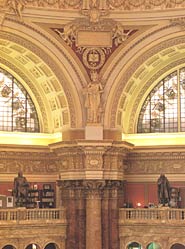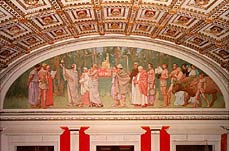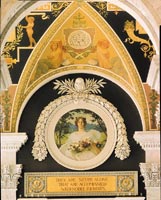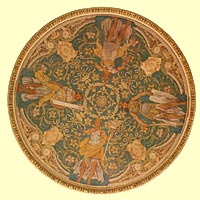Second Floor
 In
the vaulted ceiling of the East Corridor are a series of eight paintings
by George Barse Jr. depict figures that represent various facets of Literature.
Along the center of the ceiling is a series of three paintings on the
Life of Man by William A. Mackay, representing infant to mature
adult and finally aged man with a cane. At the north and south ends of
the ceiling is a tablet bearing the names of Americans who made significant
contributions to the machinery and production of printing. In
the vaulted ceiling of the East Corridor are a series of eight paintings
by George Barse Jr. depict figures that represent various facets of Literature.
Along the center of the ceiling is a series of three paintings on the
Life of Man by William A. Mackay, representing infant to mature
adult and finally aged man with a cane. At the north and south ends of
the ceiling is a tablet bearing the names of Americans who made significant
contributions to the machinery and production of printing.
At the rear of the East Corridor is a staircase that leads to a Visitors'
Gallery from which you can view the Main Reading Room (pictured in
the image on the right). On the first landing as you go up the staircase,
observe in front of you Elihu Vedder's large marble mosaic portrait of
the Minerva of Peace, part of her armor laid aside, standing
guard before the Main Reading Room. On her right is a statue of Victory;
at her left, her symbol, the owl. She is holding in her hand a scroll
that lists various departments of learning, science and art.
 From
the Visitors' Gallery you will be able to see the domed ceiling, stretching
160 feet above the floor of the Main Reading Room (picture on the left).
The female figure painted in the cupola by Edwin Blashfield represents
Human Understanding, which is visible only to those in the Reading
Room below (not visible in the image on the left). The dozen 10-foot-high
figures in the circular mural at the apex of the dome, also painted by
Blashfield, represent the countries or epochs that contributed to the
development of Western civilization. Stained glass representations of
the seals of 48 states (excluding Alaska and Hawaii) adorn the eight semicircular
windows surrounding the Reading Room. Eight giant marble columns each
support 10-foot-high allegorical female figures in plaster representing
characteristic features of civilized life and thought: Religion,
Commerce, History, Art, Philosophy,
Poetry, Law and Science. From
the Visitors' Gallery you will be able to see the domed ceiling, stretching
160 feet above the floor of the Main Reading Room (picture on the left).
The female figure painted in the cupola by Edwin Blashfield represents
Human Understanding, which is visible only to those in the Reading
Room below (not visible in the image on the left). The dozen 10-foot-high
figures in the circular mural at the apex of the dome, also painted by
Blashfield, represent the countries or epochs that contributed to the
development of Western civilization. Stained glass representations of
the seals of 48 states (excluding Alaska and Hawaii) adorn the eight semicircular
windows surrounding the Reading Room. Eight giant marble columns each
support 10-foot-high allegorical female figures in plaster representing
characteristic features of civilized life and thought: Religion,
Commerce, History, Art, Philosophy,
Poetry, Law and Science.

The 16 bronze statues set upon the balustrades of the galleries pay homage
to men whose lives symbolized the thought and activity represented by
the plaster statues below. Included are Moses and St. Paul (Religion);
Christopher Columbus and Robert Fulton (Commerce); Herodotus
and Edward Gibbon (History); Michelangelo and Ludwig van Beethoven
(Art); Plato and Francis Bacon (Philosophy); Homer and
William Shakespeare (Poetry); Solon and James Kent (Law);
and Isaac Newton and Joseph Henry (Science). The circle of knowledge
is completed by the reader desks, as users of the Main Reading Room make
their own contributions to the various fields of knowledge represented
by the paintings and statuary in the room. Visit the Main
Reading Room as well as all of the other online reading room and information
center home pages via the Services for
Researchers page.
North Corridor
 In
the North Corridor of the Great Hall, you will see ceiling paintings by
Robert Reid representing The Five Senses. Beginning at the west
end or the front of the building, they are Taste, Sight,
Smell, Hearing and Touch. In the four circular
paintings along the wall, Reid has portrayed Wisdom (shown
on the left), Understanding, Knowledge, Philosophy.
In the arch beneath the ceiling at the west end of the corridor are five
semicircular or circular tablets, two of which contain the obverse and
reverse of the Great Seal of the United States. The other three carry
inscriptions from Pope, Cicero and Emerson regarding order, memory and
beauty, respectively. In the same position at the opposite or eastern
end of the corridor is a painting of the Western Hemisphere. In
the North Corridor of the Great Hall, you will see ceiling paintings by
Robert Reid representing The Five Senses. Beginning at the west
end or the front of the building, they are Taste, Sight,
Smell, Hearing and Touch. In the four circular
paintings along the wall, Reid has portrayed Wisdom (shown
on the left), Understanding, Knowledge, Philosophy.
In the arch beneath the ceiling at the west end of the corridor are five
semicircular or circular tablets, two of which contain the obverse and
reverse of the Great Seal of the United States. The other three carry
inscriptions from Pope, Cicero and Emerson regarding order, memory and
beauty, respectively. In the same position at the opposite or eastern
end of the corridor is a painting of the Western Hemisphere.
Northwest Gallery and Pavilion
 The
Northwest Gallery and Pavilion is used from time to time for changing
exhibitions. The murals at each end of the long gallery were painted by
Gari Melchers, echoing themes of paintings he had done for the World's
Columbian Exposition at Chicago in 1893. They are War at the
far or north end of the room as you enter from the Great Hall; and Peace
(shown on the right) at the south end. The far end of the gallery
opens to the domed Pavilion of Art and Science containing murals by William
de Leftwich Dodge depicting Literature, Music, Science
and Art. In the apex of the dome is his painting of Ambition,
considered the incentive for all human effort. There are similar pavilion
spaces in all four corners of the first and second floors of the Jefferson
Building. The African and Middle
Eastern Reading Room is located off of the Pavilion of Art and Science. The
Northwest Gallery and Pavilion is used from time to time for changing
exhibitions. The murals at each end of the long gallery were painted by
Gari Melchers, echoing themes of paintings he had done for the World's
Columbian Exposition at Chicago in 1893. They are War at the
far or north end of the room as you enter from the Great Hall; and Peace
(shown on the right) at the south end. The far end of the gallery
opens to the domed Pavilion of Art and Science containing murals by William
de Leftwich Dodge depicting Literature, Music, Science
and Art. In the apex of the dome is his painting of Ambition,
considered the incentive for all human effort. There are similar pavilion
spaces in all four corners of the first and second floors of the Jefferson
Building. The African and Middle
Eastern Reading Room is located off of the Pavilion of Art and Science.
Other Features
  In
each of the four corners of the Great Hall, are a series of panels, painted
in rich Pompeian red with female figures representing The Virtues,
by George Willoughby Maynard. Eight in all, Industry and Concord
are located at the northwest corner; Fortitude and Justice
(shown on the right and left) are found in the northeast corner;
Temperance and Prudence are located at the southwest
corner; and Patriotism and Courage are found in the
southeast corner. Another interesting feature is the series of 56 printers'
marks that adorn the triangular penetrations of the ceiling vaults all
around the four corridors of the Second Floor of the Great Hall. These
marks are reproductions of the devices that early printers used on the
title pages of their books, partly as a kind of informal trademark to
protect their work and partly as a personal emblem representing a publisher
of good standing. Some more modern printers marks may be found along the
north corridor, along with that of one of the most famous printers of
all time, William Caxton. In
each of the four corners of the Great Hall, are a series of panels, painted
in rich Pompeian red with female figures representing The Virtues,
by George Willoughby Maynard. Eight in all, Industry and Concord
are located at the northwest corner; Fortitude and Justice
(shown on the right and left) are found in the northeast corner;
Temperance and Prudence are located at the southwest
corner; and Patriotism and Courage are found in the
southeast corner. Another interesting feature is the series of 56 printers'
marks that adorn the triangular penetrations of the ceiling vaults all
around the four corridors of the Second Floor of the Great Hall. These
marks are reproductions of the devices that early printers used on the
title pages of their books, partly as a kind of informal trademark to
protect their work and partly as a personal emblem representing a publisher
of good standing. Some more modern printers marks may be found along the
north corridor, along with that of one of the most famous printers of
all time, William Caxton.
West and South Corridors
The ceiling paintings in the vaults of the west corridor by Walter Shirlaw
depict The Sciences. At either end of the ceiling is a tablet
bearing a list of names of men distinguished in the sciences that are
represented in the paintings. There are also three medallions in the center
of the corridor by William B. Van Ingen depicting Sculpture,
Architecture and Painting.
 The
South Corridor parallels the north. Frank W. Benson's paintings at the center
of the vaulted ceiling depict The Three Graces, balancing Reid's
paintings from the North Corridor. Appearing in the arch at the western
end are painted semicircular and circular medallions, containing a caduceus,
associated with the Greek god Hermes, and a lictor's ax, carried by an official
before a Roman magistrate to show authority. At the opposite end, echoing
the Western Hemisphere painted in the North Corridor, is a painting of the
Eastern Hemisphere. The
South Corridor parallels the north. Frank W. Benson's paintings at the center
of the vaulted ceiling depict The Three Graces, balancing Reid's
paintings from the North Corridor. Appearing in the arch at the western
end are painted semicircular and circular medallions, containing a caduceus,
associated with the Greek god Hermes, and a lictor's ax, carried by an official
before a Roman magistrate to show authority. At the opposite end, echoing
the Western Hemisphere painted in the North Corridor, is a painting of the
Eastern Hemisphere.
The four circular wall paintings in the South Corridor, also by Benson,
depict The Four Seasons. The artist has painted a half-length
figure of a beautiful young woman to represent each season, using subtle
differences in colors, foliage and background to distinguish one season
from another (pictured on the right is Summer).
Southwest Gallery and Pavilion (Treasures Gallery)
Located in the Southwest Gallery and Pavilion to your right as you walk
through the South Corridor is the Treasures
Gallery, which features a permanent exhibition of some of the Library's
most interesting and significant treasures of American history as well
as unique and fascinating examples of the nation's cultural heritage.
 The
large murals at each end of the Treasures Gallery were painted by Kenyon
Cox. The Sciences are the subject of the painting at the far
end of the gallery as you enter from the Great Hall; The Arts
are shown in the mural at the north end, behind you. The far end of the
Treasures Gallery opens to domed Pavilion of the Discoverers. The
paintings here are the work of George W. Maynard, and the subjects are:
Adventure, Discovery, Conquest and Civilization.
The spirit of Adventure leads to Discovery, which in
turn leads to Conquest and then Civilization. At the
center of the dome, Maynard has selected the four qualities he finds are
the most appropriate to these four stages of a nation's development: Courage,
Valor, Fortitude and Achievement. Located off
of the Southwest Pavilion, is the European
Reading Room. The
large murals at each end of the Treasures Gallery were painted by Kenyon
Cox. The Sciences are the subject of the painting at the far
end of the gallery as you enter from the Great Hall; The Arts
are shown in the mural at the north end, behind you. The far end of the
Treasures Gallery opens to domed Pavilion of the Discoverers. The
paintings here are the work of George W. Maynard, and the subjects are:
Adventure, Discovery, Conquest and Civilization.
The spirit of Adventure leads to Discovery, which in
turn leads to Conquest and then Civilization. At the
center of the dome, Maynard has selected the four qualities he finds are
the most appropriate to these four stages of a nation's development: Courage,
Valor, Fortitude and Achievement. Located off
of the Southwest Pavilion, is the European
Reading Room.
 Library of Congress
Library of Congress
Contact Us (
May 18, 2007
)
|


 The
South Corridor parallels the north. Frank W. Benson's paintings at the center
of the vaulted ceiling depict The Three Graces, balancing Reid's
paintings from the North Corridor. Appearing in the arch at the western
end are painted semicircular and circular medallions, containing a caduceus,
associated with the Greek god Hermes, and a lictor's ax, carried by an official
before a Roman magistrate to show authority. At the opposite end, echoing
the Western Hemisphere painted in the North Corridor, is a painting of the
Eastern Hemisphere.
The
South Corridor parallels the north. Frank W. Benson's paintings at the center
of the vaulted ceiling depict The Three Graces, balancing Reid's
paintings from the North Corridor. Appearing in the arch at the western
end are painted semicircular and circular medallions, containing a caduceus,
associated with the Greek god Hermes, and a lictor's ax, carried by an official
before a Roman magistrate to show authority. At the opposite end, echoing
the Western Hemisphere painted in the North Corridor, is a painting of the
Eastern Hemisphere.